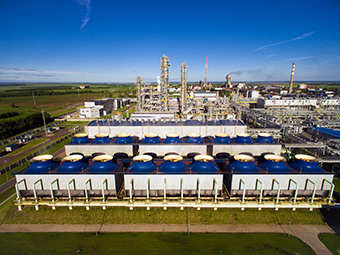Fertilizer Manufacturing Effluent Guidelines
 EPA initially promulgated the Fertilizer Manufacturing Effluent Guidelines and Standards (40 CFR Part 418) in 1974 and 1975, and amended the regulation between 1975 and 1987. The regulation covers direct
EPA initially promulgated the Fertilizer Manufacturing Effluent Guidelines and Standards (40 CFR Part 418) in 1974 and 1975, and amended the regulation between 1975 and 1987. The regulation covers direct![]() direct dischargerA point source that discharges pollutants to waters of the United States, such as streams, lakes, or oceans. and indirect
direct dischargerA point source that discharges pollutants to waters of the United States, such as streams, lakes, or oceans. and indirect![]() indirect dischargerA facility that discharges pollutants to a publicly owned treatment works (municipal sewage treatment plant). dischargers. The Effluent Guidelines and Standards are incorporated into NPDES permits for direct dischargers and permits or other control mechanisms for indirect dischargers (see Pretreatment Program).
indirect dischargerA facility that discharges pollutants to a publicly owned treatment works (municipal sewage treatment plant). dischargers. The Effluent Guidelines and Standards are incorporated into NPDES permits for direct dischargers and permits or other control mechanisms for indirect dischargers (see Pretreatment Program).
What is the Fertilizer Manufacturing Industry?
The industry manufactures five basic fertilizer chemicals: phosphate, ammonia, urea, ammonium nitrate and nitric acid. "Straight" fertilizers contain only a single nutrient. "Mixed" fertilizers contain two or more primary nutrients. Mixed fertilizers can be produced by chemically reacting different ingredients and utilizing the chemical reaction as the binding force; or simply by mechanically blending together straight fertilizers.
The fertilizer industry is composed of multi-product manufacturing plants. Phosphate-based products and ammonia-based products are typically produced at different plants.
Phosphate fertilizer manufacturing comprises two principal units: production of sulfuric acid, derived from elemental sulfur, and wet process phosphoric acid, derived from phosphate rock. Principal products include phosphoric acid, normal superphosphate, triple superphosphate, and ammonium phosphates. Some phosphate plants also produce fluosilicic acid, which is commonly used for fluoridation of drinking water.
Ammonia is manufactured using atmospheric nitrogen and hydrogen derived from natural gas or petroleum refinery byproducts. Ammonia is sold as a straight ferilizer, and is used to manufacture urea, ammonium nitrate and nitric acid products.
- Process condensate
- Treatment plant effluent
- Cooling tower blowdown
- Boiler blowdown
- Gypsum pond water
- Crystal wash water (formulated fertilizer plants)
- Compressor blowdown (ammonia plants)
- Spills and leaks
- Surface runoff from precipitation
- 325311: Nitrogenous Fertilizer Manufacturing
- 325312: Phosphatic Fertilizer Manufacturing
- 325314: Fertilizer (Mixing Only) Manufacturing
The NAICS listing is provided as a guide and does not define the coverage of the Fertilizer Manufacturing category. For precise definitions of coverage, see the applicability sections in 40 CFR Part 418.
Pollutants and Subcategories
Regulated Pollutants
- ammonia
- BOD5
- fluoride
- nitrate
- organic nitrogen
- pH
- total phosphorous
- TSS
Regulation Subcategories
- Phosphate
- Ammonia
- Urea
- Ammonium Nitrate
- Nitric Acid
- Ammonium Sulfate Production
- Mixed and Blend Fertilizer Production
Rulemaking History
Amendments
- BCT amendments:
- Revised methodology documents:
- Final Rule (July 9, 1986)
- Proposed Rule (October 29, 1982)
- Initial methodology documents:
- Final Rule (August 29, 1979)
- Proposed Rule (August 23, 1978)
- Revised methodology documents:
In addition to the BCT amendments, portions of Part 418 were revised between 1975 and 1987 pursuant to litigation. For the current regulatory requirements see 40 CFR Part 418.
Initial Rulemaking
1975 rule
-
-
Final Rule (January 14, 1975)
-
Development Document (January 1975)
Industry description, wastewater characterization, treatment technologies, regulatory compliance cost estimates and pollutant loadings for the final rule -
Proposed Rule (October 7, 1974)
-
1974 rule
-
-
Final Rule (April 8, 1974)
-
Development Document (March 1974)
Industry description, wastewater characterization, treatment technologies, regulatory compliance cost estimates and pollutant loadings for the final rule -
Proposed Rule (December 7, 1973)
-
Additional Information
For additional information regarding Fertilizer Manufacturing Effluent Guidelines, please contact Ahmar Siddiqui (siddiqui.ahmar@epa.gov) or 202-566-1044.
